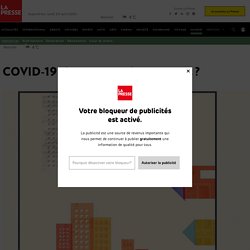

COVID-19 : les prix sont-ils immunisés ? Visites en personne annulées, ralentissement des transactions sur le marché montréalais, vendeurs et acquéreurs dans l’expectative : si certains acheteurs espèrent que la crise de la COVID-19 pourrait mettre un frein à la fièvre des prix de l’immobilier dans la métropole et ses alentours, ils devraient calmer leurs ardeurs.

Une baisse des prix s’avère peu probable, surtout si la crise se résorbe rapidement, croient les professionnels du milieu. RCA students develop SaltyCo fabrics using freshwater-free plants. Students from the Royal College of Art have made fabrics from plants grown in seawater, providing a potential solution for the currently freshwater-intensive fashion and textile industries.

While cotton is notoriously water-hungry, requiring as much as 20,000 litres of freshwater to produce just a kilogram of the material, these fabrics are made from a salt-tolerant plant that thrives in seawater. Insulating jacket liners, faux leather and clothing like t-shirts and trousers could all potentially be made with the fabrics. The students – an interdisciplinary team from the Imperial College London and the Royal College of Art – came together to find a way to tackle the global overconsumption of freshwater. Barbican flat by Intervention Architecture turns into ballet studio. Intervention Architecture has installed shapeshifting furniture in a Barbican apartment in London, allowing it to transform from a home into a dance studio. Barbican Dancer's Studio is a compact studio flat in the Barbican Estate, owned by a professional ballet dancer. With very little space on offer, the challenge for Intervention Architecture was to create generous spaces for eating and sleeping, but to also give the client the room he needed to practice his choreography.
The Birmingham-based studio did this by developing a a multi-purpose piece of plywood furniture that can take on various configurations. Mobile and folding elements integrate seating, surfaces, storage and a bed. "We injected movement within the space with a changeable joinery solution to maximise storage, and create alternate uses and zones within a compact floor area," explained studio director Anna Parker. The space-saving furniture is made up of several modules. Photography is by Handover. MIT develops low-cost smart diaper that notifies parents when wet. Researchers at MIT have invented a low-cost moisture sensor for disposable nappies that uses radio frequencies to alert caregivers when babies need changing.

The sensor is able to detect when a nappy is damp and send a notification to the caregiver via their phone or computer, ultimately cutting down on diaper rash and other problems that stem from late changing. While typical sensors of this sort would need batteries and wireless or Bluetooth transmitters, the team from MIT's Auto-ID Lab achieved a similar outcome using a small, simple sensor that they estimate would cost less than two cents to manufacture. The system works using a passive radio frequency identification (RFID) tag, which sits in the bottom layer of the nappy and works in conjunction with a nearby RFID reader. Diaper conditions communicated via radio waves. Dezeen. This collection of cloth and metal-wire garments by Brazilian fashion designer Karoline Vitto finds beauty in the bulges of flesh that women are encouraged to cover up.

Designed as part of her masters degree at London's Royal College of Art, Vitto's The Body as Material collection features seven garments that accentuate the rolls and curves of the female form in different ways. The graduate told Dezeen how the project came from "a very personal place", inspired by her own relationship with her body over the years. Dezeen. Underwear, vegetables and carrier bags could all be used in the fight against coronavirus, suggests artist Max Siedentopf.

Siedentopf, a German-Namibian designer based in London, has created a series of provocative images showing everyday items being used as protective face masks. Global demand for surgical face masks is growing, as people try to protect themselves against the virus. Dezeen. For his graduate collection at the London College of Fashion, menswear designer Harikrishnan has matched cropped tailored jackets with billowing latex trousers to create exaggerated silhouettes.

The super-wide inflatable trousers consist of up to 30 individual latex panels, which are either plain white or arranged in contrasting colour blocks of brick red and forest or mint green. Although they fit snugly at the waist, they balloon out to double the width of the wearer around the thighs, before finally tapering in again towards the ankles.
This look is achieved by pumping the trousers with air via a seven millimetre-wide inflation valve at the bottom. Rie Sakamoto knits rubber bands together like yarn for elastic garments. Japanese designer Rie Sakamoto replaced yarn with rubber bands for her knitted fashion collection, which aims to showcase this stationary item's overlooked qualities.

Created as part of her thesis project for Tama Art University in Tokyo, Japan, the Rubber Band collection comprises a series of garments made entirely from elastic bands. Including a dress and a jacket, the collection aims to shine a light on simple, everyday objects that may be ignored in contemporary design and reestablish them as art. As Sakamoto told Dezeen, she decided to work with elastic bands after noticing the beauty in their aesthetic qualities. She knitted several bands together and held them up to the sunlight, becoming aware of their soft texture, high elasticity, sheerness and "beautiful candy colour". Their stretchy quality lends itself to clothing, she said, as it enables the material to morph to different body-shapes and sizes According to the designer, it took her up to half a year to finish the project. 62 nouveaux décès liés à la COVID-19, pour un total de 939 au Québec. (Québec) Le nombre de décès liés à la COVID-19 continue de grimper au Québec alors que le gouvernement Legault confirme 62 nouveaux morts lundi, portant le total à 939 depuis le début de la pandémie.

Notre erreur sur les masques. La lettre est datée du 31 mars.

Un étudiant coréen montréalais m’écrit. Il ne comprend pas ce qui se passe ici. Ni ailleurs en Occident, au fait. Publié le 20 avril 2020 à 6h00 ✓ Lien copié YVES BOISVERT La Presse Hé, les amis, c’est quoi votre problème avec les masques ? Ce n’était pas écrit comme ça, c’était beaucoup plus poli. Mais pensez que l’Organisation mondiale de la santé (OMS) elle-même RECOMMANDAIT de ne pas porter de masque pour les civils. Drones and self-driving robots used to fight coronavirus in China. China is deploying robots and drones to remotely disinfect hospitals, deliver food and enforce quarantine restrictions as part of the effort to fight coronavirus.

Chinese state media has reported that drones and robots are being used by the government to cut the risk of person-to-person transmission of the disease. There are 780 million people that are on some form of residential lockdown in China. Scientists make first living robots from frog cells. A team of scientists at Tufts University in the US have created xenobots, tiny robots made from frog skin and heart cells that can walk, work together and heal themselves. Algorithms define the configurations of frog cells, which are then constructed by humans to create a living robot that the scientists have called a xenobot, after the Xenopus laevis species of frog they are made from. These aquatic organisms live for up to seven days, and the team hopes that in future they can be used to deliver drugs into people's bloodstreams, clean up microplastics from the ocean, or manage radioactive waste spills.
A number of variations of the 0.7 millimetre-long robots are designed using a computer algorithm. "Computers model the dynamics of the biological building blocks (skin and heart muscle) and use them like LEGO bricks to build different organism anatomies," said the team of scientists. Hausse marquée de mises en chantier au Québec le mois dernier.
La construction résidentielle au Québec a commencé l’année 2020 avec le vent dans les voiles, si on se fie aux données publiées lundi par la Société canadienne d’hypothèques et de logement (SCHL). Pangaia's puffer jackets are filled with wildflowers rather than down. US clothing brand Pangaia has released a puffer coat, whose filling is made with flowers in a bid to offer a cruelty-free alternative to duck or goose down. The stuffing, called Flower Down, was created over 10 years of research and development and combines wildflowers with an aerogel and a biopolymer to create a durable thermal insulation material. This is contained in a quilted shell made from recycled polyester, which is rendered in classic black, white or navy. "We use a type of wildflower that is easy to find and has a particular fibrous quality," explained Dr.
La fibre de chanvre, matériau de l’avenir? Lorsqu’il s’est lancé dans la culture de cette plante, il y a 10 ans, c’était surtout pour vendre son grain, très recherché à l’époque, rappelle-t-il. Peu de fermiers cultivaient de la graine de chanvre, donc elle se vendait 30 % de plus que mes autres cultures.